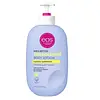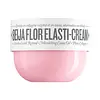EOS Shea Better Moisture Body Lotion Versus Sol De Janeiro Beija Flor™ Elasti-Cream with Collagen and Squalane
What's inside
What's inside
 Key Ingredients
Key Ingredients

 Benefits
Benefits

 Concerns
Concerns

 Ingredients Side-by-side
Ingredients Side-by-side

Water
Skin ConditioningGlycerin
HumectantIsopropyl Palmitate
EmollientCetyl Ethylhexanoate
EmollientGlyceryl Stearate Se
EmulsifyingCetyl Alcohol
EmollientParfum
MaskingDimethicone
EmollientButyrospermum Parkii Butter
Skin ConditioningButyrospermum Parkii Oil
EmollientPetrolatum
EmollientParaffinum Liquidum
EmollientCarbomer
Emulsion StabilisingCaprylyl Glycol
EmollientHexylene Glycol
EmulsifyingPhenoxyethanol
PreservativePalmitic Acid
EmollientStearic Acid
CleansingMyristic Acid
CleansingDisodium EDTA
Sodium Hydroxide
BufferingTocopheryl Acetate
AntioxidantCitric Acid
BufferingWater, Glycerin, Isopropyl Palmitate, Cetyl Ethylhexanoate, Glyceryl Stearate Se, Cetyl Alcohol, Parfum, Dimethicone, Butyrospermum Parkii Butter, Butyrospermum Parkii Oil, Petrolatum, Paraffinum Liquidum, Carbomer, Caprylyl Glycol, Hexylene Glycol, Phenoxyethanol, Palmitic Acid, Stearic Acid, Myristic Acid, Disodium EDTA, Sodium Hydroxide, Tocopheryl Acetate, Citric Acid
Water
Skin ConditioningCetearyl Alcohol
EmollientParfum
MaskingCaprylic/Capric Triglyceride
MaskingIsopentyldiol
HumectantGlyceryl Stearate
EmollientC13-16 Isoparaffin
SolventGlycerin
HumectantPyrus Malus Fruit Extract
Skin ConditioningCetyl Alcohol
EmollientCocos Nucifera Oil
MaskingCaryodendron Orinocense Seed Oil
EmollientButyrospermum Parkii Butter
Skin ConditioningBehenyl Alcohol
EmollientSqualane
EmollientCollagen Amino Acids
MoisturisingTheobroma Grandiflorum Seed Butter
Skin ConditioningCopaifera Officinalis Resin
MaskingAstrocaryum Vulgare Kernel Oil
Skin ConditioningAstrocaryum Murumuru Seed Butter
EmollientDaucus Carota Sativa Root Extract
Skin ConditioningTocopherol
AntioxidantOryza Sativa Bran Extract
Skin ConditioningRosmarinus Officinalis Leaf Extract
AntimicrobialHelianthus Annuus Seed Oil
EmollientHelianthus Annuus Extract
EmollientEthylhexylglycerin
Skin ConditioningPentylene Glycol
Skin ConditioningHeptyl Undecylenate
EmollientPotassium Cetyl Phosphate
EmulsifyingTetrasodium Glutamate Diacetate
Xanthan Gum
EmulsifyingCitric Acid
BufferingSodium Hydroxide
BufferingPhenoxyethanol
PreservativeMica
Cosmetic ColorantAlpha-Isomethyl Ionone
PerfumingBenzyl Salicylate
PerfumingCI 77891
Cosmetic ColorantWater, Cetearyl Alcohol, Parfum, Caprylic/Capric Triglyceride, Isopentyldiol, Glyceryl Stearate, C13-16 Isoparaffin, Glycerin, Pyrus Malus Fruit Extract, Cetyl Alcohol, Cocos Nucifera Oil, Caryodendron Orinocense Seed Oil, Butyrospermum Parkii Butter, Behenyl Alcohol, Squalane, Collagen Amino Acids, Theobroma Grandiflorum Seed Butter, Copaifera Officinalis Resin, Astrocaryum Vulgare Kernel Oil, Astrocaryum Murumuru Seed Butter, Daucus Carota Sativa Root Extract, Tocopherol, Oryza Sativa Bran Extract, Rosmarinus Officinalis Leaf Extract, Helianthus Annuus Seed Oil, Helianthus Annuus Extract, Ethylhexylglycerin, Pentylene Glycol, Heptyl Undecylenate, Potassium Cetyl Phosphate, Tetrasodium Glutamate Diacetate, Xanthan Gum, Citric Acid, Sodium Hydroxide, Phenoxyethanol, Mica, Alpha-Isomethyl Ionone, Benzyl Salicylate, CI 77891
 Reviews
Reviews

Ingredients Explained
These ingredients are found in both products.
Ingredients higher up in an ingredient list are typically present in a larger amount.
This ingredient is also known as shea butter. It is an effective skin hydrator and emollient.
Emollients help soothe and soften your skin. It does this by creating a protective film on your skin. This barrier helps trap moisture and keeps your skin hydrated. Emollients may be effective at treating dry or itchy skin.
Shea butter is rich in antioxidants. Antioxidants help fight free-radicals, or molecules that may harm the body. It is also full of fatty acids including stearic acid and linoleic acid. These acids help replenish the skin and keep skin moisturized.
While Shea Butter has an SPF rating of about 3-4, it is not a sunscreen replacement.
Shea butter may not be fungal acne safe. We recommend speaking with a professional if you have any concerns.
Learn more about Butyrospermum Parkii ButterCetyl Alcohol is a fatty alcohol. Fatty Alcohols are most often used as an emollient or to thicken a product.
Its main roles are:
Though it has "alcohol" in the name, it is not related to denatured alcohol or ethyl alcohol.
The FDA allows products labeled "alcohol-free" to have fatty alcohols.
Learn more about Cetyl AlcoholCitric Acid is an alpha hydroxy acid (AHA) naturally found in citrus fruits like oranges, lemons, and limes.
Like other AHAs, citric acid can exfoliate skin by breaking down the bonds that hold dead skin cells together. This helps reveal smoother and brighter skin underneath.
However, this exfoliating effect only happens at high concentrations (20%) which can be hard to find in cosmetic products.
Due to this, citric acid is usually included in small amounts as a pH adjuster. This helps keep products slightly more acidic and compatible with skin's natural pH.
In skincare formulas, citric acid can:
While it can provide some skin benefits, research shows lactic acid and glycolic acid are generally more effective and less irritating exfoliants.
Most citric acid used in skincare today is made by fermenting sugars (usually from molasses). This synthetic version is identical to the natural citrus form but easier to stabilize and use in formulations.
Read more about some other popular AHA's here:
Learn more about Citric AcidGlycerin is already naturally found in your skin. It helps moisturize and protect your skin.
A study from 2016 found glycerin to be more effective as a humectant than AHAs and hyaluronic acid.
As a humectant, it helps the skin stay hydrated by pulling moisture to your skin. The low molecular weight of glycerin allows it to pull moisture into the deeper layers of your skin.
Hydrated skin improves your skin barrier; Your skin barrier helps protect against irritants and bacteria.
Glycerin has also been found to have antimicrobial and antiviral properties. Due to these properties, glycerin is often used in wound and burn treatments.
In cosmetics, glycerin is usually derived from plants such as soybean or palm. However, it can also be sourced from animals, such as tallow or animal fat.
This ingredient is organic, colorless, odorless, and non-toxic.
Glycerin is the name for this ingredient in American English. British English uses Glycerol/Glycerine.
Learn more about GlycerinParfum is a catch-all term for an ingredient or more that is used to give a scent to products.
Also called "fragrance", this ingredient can be a blend of hundreds of chemicals or plant oils. This means every product with "fragrance" or "parfum" in the ingredients list is a different mixture.
For instance, Habanolide is a proprietary trade name for a specific aroma chemical. When used as a fragrance ingredient in cosmetics, most aroma chemicals fall under the broad labeling category of “FRAGRANCE” or “PARFUM” according to EU and US regulations.
The term 'parfum' or 'fragrance' is not regulated in many countries. In many cases, it is up to the brand to define this term.
For instance, many brands choose to label themselves as "fragrance-free" because they are not using synthetic fragrances. However, their products may still contain ingredients such as essential oils that are considered a fragrance by INCI standards.
One example is Calendula flower extract. Calendula is an essential oil that still imparts a scent or 'fragrance'.
Depending on the blend, the ingredients in the mixture can cause allergies and sensitivities on the skin. Some ingredients that are known EU allergens include linalool and citronellol.
Parfum can also be used to mask or cover an unpleasant scent.
The bottom line is: not all fragrances/parfum/ingredients are created equally. If you are worried about fragrances, we recommend taking a closer look at an ingredient. And of course, we always recommend speaking with a professional.
Learn more about ParfumPhenoxyethanol is a preservative that has germicide, antimicrobial, and aromatic properties. Studies show that phenoxyethanol can prevent microbial growth. By itself, it has a scent that is similar to that of a rose.
It's often used in formulations along with Caprylyl Glycol to preserve the shelf life of products.
Sodium Hydroxide is also known as lye or caustic soda. It is used to adjust the pH of products; many ingredients require a specific pH to be effective.
In small amounts, sodium hydroxide is considered safe to use. However, large amounts may cause chemical burns due to its high alkaline.
Your skin has a natural pH and acid mantle. This acid mantle helps prevent harmful bacteria from breaking through. The acid mantle also helps keep your skin hydrated.
"Alkaline" refers to a high pH level. A low pH level would be considered acidic.
Learn more about Sodium HydroxideWater. It's the most common cosmetic ingredient of all. You'll usually see it at the top of ingredient lists, meaning that it makes up the largest part of the product.
So why is it so popular? Water most often acts as a solvent - this means that it helps dissolve other ingredients into the formulation.
You'll also recognize water as that liquid we all need to stay alive. If you see this, drink a glass of water. Stay hydrated!
Learn more about Water